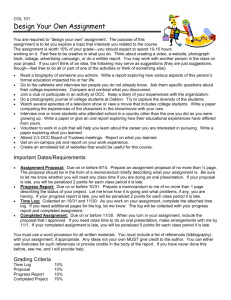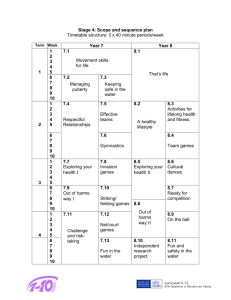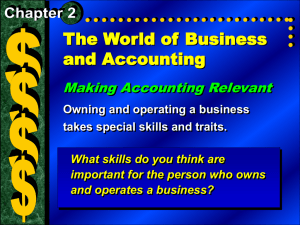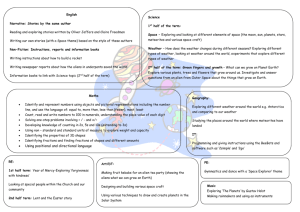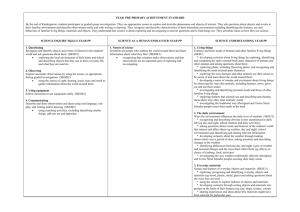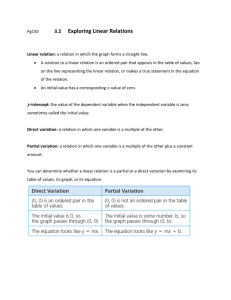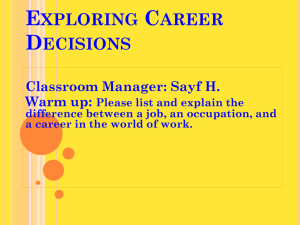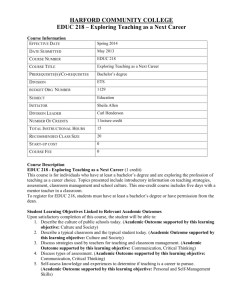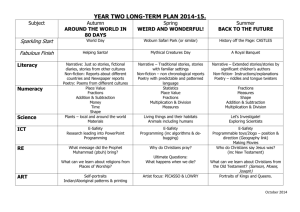Fundamentals of Technology Study Guide Objectives 3.01
advertisement
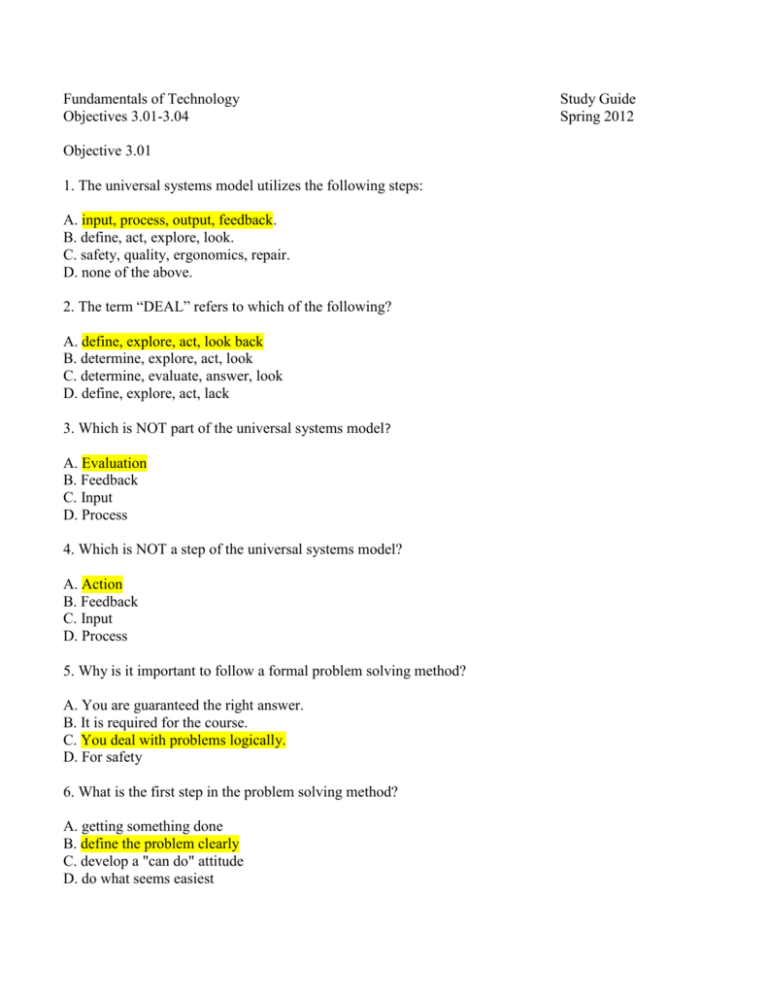
Fundamentals of Technology Objectives 3.01-3.04 Objective 3.01 1. The universal systems model utilizes the following steps: A. input, process, output, feedback. B. define, act, explore, look. C. safety, quality, ergonomics, repair. D. none of the above. 2. The term “DEAL” refers to which of the following? A. define, explore, act, look back B. determine, explore, act, look C. determine, evaluate, answer, look D. define, explore, act, lack 3. Which is NOT part of the universal systems model? A. Evaluation B. Feedback C. Input D. Process 4. Which is NOT a step of the universal systems model? A. Action B. Feedback C. Input D. Process 5. Why is it important to follow a formal problem solving method? A. You are guaranteed the right answer. B. It is required for the course. C. You deal with problems logically. D. For safety 6. What is the first step in the problem solving method? A. getting something done B. define the problem clearly C. develop a "can do" attitude D. do what seems easiest Study Guide Spring 2012 7. Why is it critical to first clearly define the problem? A. ensures you address the correct issue B. ensures you will do everything correctly C. ensures you will get the right answer D. allows you to brainstorm 8. When you build a solution to a problem it is important that you test its performance because: A. evaluation enables you to correct or improve its performance B. the first solution is never correct C. because it is the third step in the problem solving method D. because it is the first step in the problem solving method 9. The acronym or initials for our problem solving method is: A. S.O.L.V.E. B. A.C.T. C. P.R.O.B. D. D.E.A.L. 10. The second step in the problem solving method: A. flow diagram B. work hard C. explore all possible solutions D. act on the problem 11. In problem solving, when exploring all possible solutions: A. dismiss poor ideas at once B. consider the consequences of each C. consider nothing D. let others narrow down the choices 12. The third step in the problem solving method is: A. Act on the best solution B. Exploring all possible solutions C. Define the problem D. Defining the solution 13. After exploring all possible solutions, you then: A. define the solution B. define the problem C. act on the best solution D. act on all solutions 14. The fourth step in the problem solving method is: A. defining the problem B. defining the solution C. exploring all possible solutions D. look back and evaluate 15. When you look back and evaluate, it enables you to: A. make adjustments if necessary B. act on the best solution C. act on all solutions D. start all over again 16. An example of exploring all possible solutions in a group setting is: A. Brainstorming B. Debating C. Hybrid diagramming D. Nominal group work Objective 3.02 1. The universal systems model is used because it is: A. it is the way a company is measured B. it is an attempt simplify your view of a complex system. C. it is an attempt to make a system more complex D. it is a way to set up a company 2. Which represents the sequence of the universal systems model? A. input, output, feedback, process B. feedback, process, input, output C. input, process, output, feedback D. process, output, input, feedback 3. In the universal systems model, input includes the: A. design of the product B. development the product C. finished product D. sale of the product 4. In the universal systems model, process includes which one of the following? A. design of the product B. development of the product C. finished product D. sale of the product 5. In the universal systems model, output includes which one of the following? A. design of the product B. development of the product C. finished product D. sale of the product 6. The "action" part of the universal systems model is which one of the following? A. output B. process C. feedback D. input 7. The actual results of the universal systems model is: A. feedback B. process C. input D. output 8. Building a structure is a/an: A. process B. output C. input D. feedback 9. From a universal systems perspective, what is capital? A. process B. output C. input D. feedback 10. Evaluation of your system provides new information also known as: A. feedback B. input C. plans D. process Objective 3.04 1. Research is done to: A. develop a strategy B. spend time reading C. spend time writing D. gather information 2. In a research and development department, design techniques are: A. developed through trial and error. B. based upon other products under patent protection. C. produced through evaluation and testing of ideas. D. developed by only one individual. 3. Basic research is research done to: A. spend time reading B. learn more about the world around us C. solve a problem D. earn a profit 4. In research, gathering information that is already known is: A. copyrighting B. retrieving C. describing D. experimenting 5. In research, information that describes current conditions is: A. copyrighting B. retrieving C. describing D. experimenting 6. In research, after gathering information and describing current conditions the next step is: A. copyrighting B. retrieving C. describing D. experimenting 7. Generating ideas in a group setting to solve a problems is: A. teamwork B. brainstorming C. think tank D. marketing
